Carbon Footprint

Transportation, heating, electricity consumption, etc. of an individual, a country or an organization. The equivalent of greenhouse gases released into the atmosphere as a result of its activities in terms of carbon dioxide equivalent (CO₂-e) is defined as Carbon Footprint.
An organization’s carbon footprint is calculated in two contexts:
- Corporate Carbon Footprint
- Product Carbon Footprint
Corporate Carbon Footprint
Measuring the amount of greenhouse gas emissions resulting from all activities of companies during the year, such as fuel and electricity consumption, transportation, production, shipping and service procurement, in terms of carbon dioxide equivalent (CO₂-e), is called Corporate Carbon Footprint.
Corporate Carbon Footprint calculation and reporting studies are carried out based on GHG Protocol or ISO 14064-1:2018 Standard.
While the GHG Protocol includes Scope 1-2-3 emissions, the ISO 14064-1:2018 Standard requires calculation and reporting within the framework of Category 1-2-3-4-5-6 emissions.
In the GHG Protocol, when institutions calculate Scope 1-2 emissions, including Scope 3 emissions in the calculation is not mandatory, but optional.
ISO 14064-1:2018 Standard requires calculations on the basis of all categories that will affect the total carbon footprint of the company. If there are categories that the institution cannot include in the calculation, the reasons should be explained in the corporate carbon footprint report.

GHG Protocol
- Scope – 1: Direct Greenhouse Gas Emissions and Removals
- Scope – 2: Indirect Emissions from Externally Supplied Energy
- Scope – 3: Other Indirect Emissions
ISO 14064-1:2018 Standard
- Category – 1: Direct Greenhouse Gas Emissions and Removals
- Category – 2: Indirect Emissions from Externally Supplied Energy
- Category – 3: Indirect Emissions from Transportation
- Category – 4: Indirect Emissions from Products Used by the Company
- Category – 5: Indirect Emissions Related to the Use of the Company’s Products
- Category – 6: Indirect Emissions from Other Sources
Product Carbon Footprint
Evaluation of the impact of a product or service on the environment throughout its life cycle, from cradle to grave, is called Product Carbon Footprint. Product Carbon Footprint calculation is made only based on Global Warming Potential (GWP) values among the 6 parameters considered within the scope of Life Cycle Analysis.
Product Carbon Footprint calculation and reporting is based on ISO 14067 Standard. It is based on ISO 14067, ISO 14040 and ISO 14044 standards and focuses only on the carbon footprint potential of the product.